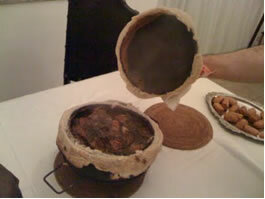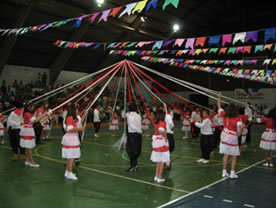The southern region of Brazil comprises the states of Rio Grande do Sul, Paraná and Santa Catarina. It presents great cultural diversity, the biggest cultural influences are from European immigrants.
Rio Grande do Sul
The gauchos from the pampas, or from the cities, form a happy people rich in traditions. Most of its cultural aspects come from German immigrants, who inhabited the region around 1824. The Italians, Spaniards and Portuguese also contributed to the cultural wealth of that State.
The gaucho, who doesn't do without the bombshell, handkerchief and poncho, enjoys chimarrão and barbecue.

Chimarrão, gaucho tradition
Most of the gaucho dances are of Portuguese origin, the Spanish dances such as the tirana and the anu are also noteworthy.
The feast of Nossa Senhora dos Navegantes, of Portuguese origin, is held in Porto Alegre on the 2nd of February, on the Guaíba River, where hundreds of boats and thousands of devotees participate in the procession river. It is also called by the people of the Watermelon festival.
Some cities in the South still celebrate the traditions of ancestors in typical festivals, such as the Festa da Uva, in Caxias do Sul (RS).
Paraná
Migrants arrived from 1850 onwards: Germans, Italians, Poles, Ukrainians, Dutch, etc. They strongly influenced the culture of the region. In addition to the Portuguese colonizers, who left their mark on the uses and customs and on the sung language of the people of Paraná.
In Paraná, the cuisine includes barreado, a meat stew. It's a typical coastal caboclo dish. It is prepared with beef, bacon and spices placed in an earthenware pot. She is buried and a fire is lit above. After 12 hours of cooking, the delicacy is ready.

Barred
Santa Catarina
Immigrant settlers arrived from the 19th century onwards. However, later the state received great influence from Italian and German settlers.
In this region of Brazil there are a lot of houses with typically European architecture.
Immigrants easily adapted to the region's subtropical climate and contributed greatly to wine growing, triticulture (culture with wheat), flax, cotton, hemp and cassava.
Some cultural events are remarkable, and mobilize many people. The boi-de-mamão, for example, goes from Christmas to Carnival. It starts with gifts and requests for help and ends with the death and resurrection of the ox.
Tape dancing is an ancient tradition. It's an ancient Aryan dance. A stick is made of ribbon, whose pole is supported in the center of the dance by a boy. From the end of the mast, pairs of ribbon come out. They perform the figurations holding the ends of their ribbons, dancing, tracing the ribbons around the central pole.

ribbon dance
In Santa Catarina, the bull on the stick is still practiced. It is a kind of practiced bullfighting. The ox, attached to a pole with a rope, invests in a puppet; until exhaustion. Other times they release the animals and the men run away, knock the ox down and tear it apart.
Another cultural event in the state is the Oktoberfest, in Blumenau (SC), a traditional beer party.
The cuisine is marked by the fish pirão, in the south of the state; and German dishes and teal in the north. In the capital, the highlight is the shrimp.
By Wagner de Cerqueira and Farncisco
Graduated in Geography
Source: Brazil School - https://brasilescola.uol.com.br/brasil/aspectos-culturais-regiao-sul.htm
